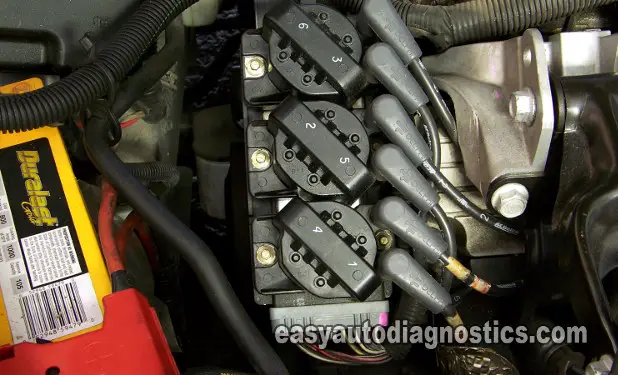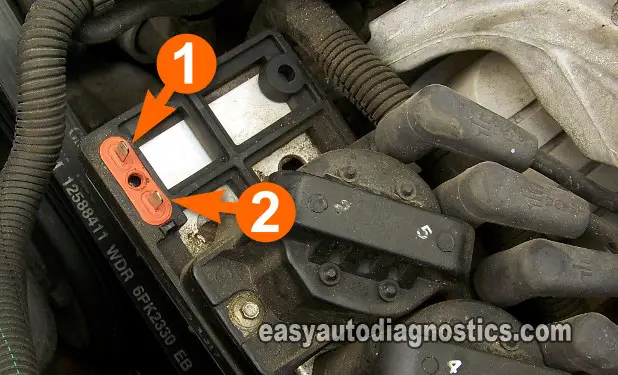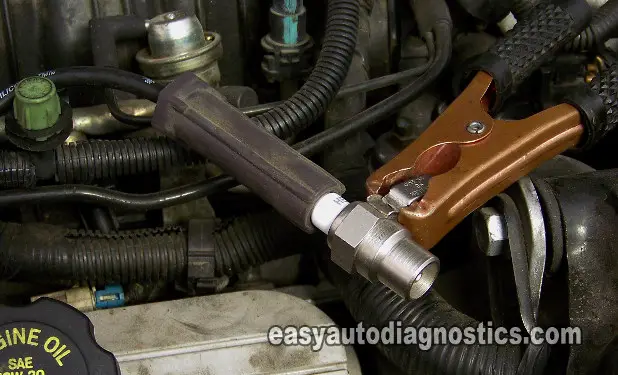
This article presents very simple and effective on-car tests of the ignition coil packs on the GM 3.8L V6 equipped engines (Buick, Chevy, Oldsmobile, Pontiac).
You'll be able to troubleshoot and diagnose a bad ignition coil, or bad spark plug wires, or a bad ignition control module as the cause of a misfire condition on your 3.8L V6 equipped GM vehicle.
Now if your car CRANKS but DOES NOT START, you may want to check the ignition control module (ICM) and 3X/18X crankshaft position sensor tests article, by clicking here: Testing The Ignition Control Module (ICM) Buick, Chevy, Pontiac, Oldsmobile 3.8L V6 Engines since this article (this one you're reading right now) concentrates on tests when the complaint is that of a vehicle that starts and runs but runs with a misfire condition.
If you're looking for the article to test the ignition coil packs on the 3.1L and 3.4L V6 GM engines, go here: GM Coil Pack Test (3.1 & 3.4 V-6 Engines).
Contents of this tutorial:
- Common Symptoms Of A Bad Ignition Coil Pack And/Or Spark Plug Wires.
- Basic Working Theory Of The 3.8L Ignition Coil Pack.
- What Tools Do I Need?
- Important Precautions, Do's And Don'ts.
- Where To Buy The Ignition Coil And Save.
- TEST 1: Testing For Spark At The Spark Plug Wire.
- TEST 2: Testing For Spark At The Ignition Coil Tower.
- TEST 3: Testing For Spark At The Ignition Coil Tower.
- TEST 4: The Power (12 V) Circuit.
- TEST 5: The Switching Signal.
- TEST 6: Other Common Misfire Causes.
![]() You can find this tutorial in Spanish here: Cómo Probar Las Bobinas De Encendido (GM 3.8L) (at: autotecnico-online.com).
You can find this tutorial in Spanish here: Cómo Probar Las Bobinas De Encendido (GM 3.8L) (at: autotecnico-online.com).
Common Symptoms Of A Bad Ignition Coil Pack And/Or Spark Plug Wires
The most common complaint is that your car (or mini-van) will start and run, but run with a misfire. Here are few others symptoms that your car or mini-van may be experiencing:
- The check engine light (CEL) will be illuminated on your instrument cluster but not always.
- Engine misfire codes:
- P0300, P0301, P0302, P0303, P0304, P0305, P0306.
- Your car will idle rough.
- A 'rotten egg' smell may come out of the tailpipe when you drive your car (or mini-van).
- Really bad gas mileage.
- Your vehicle does not pass the emissions test.
Basic Working Theory Of The 3.8L Ignition Coil Pack

In a nutshell when you turn the key to crank and start your car:
- 12 Volts flow into the ignition control module.
- This voltage is distributed by the module to the 3 ignition coils sitting on top of it and to the crankshaft position sensor assembly.
- Once the engine starts to crank, the crankshaft position sensor starts producing its signals which are sent to the ignition control module (ICM).
- When the ignition control module (ICM) receives these crank sensor signals, it starts to create a switching signal for each individual ignition coil pack.
- It's this switching signal in combination with 12 Volts that make the ignition coil packs start sparking away.
Each ignition coil sitting on top of the ignition control module (ICM) has two towers. Both towers fire off spark to two different cylinders at the exact same time. It's very important for you to note that the cylinders that get spark from the same ignition coil are called 'paired cylinders' in this article.
In case you're wondering what the heck is the switching signal, this term describes the switching ON and OFF of the Primary Current (12 Volts) that flows thru' the ignition coil by interrupting its path to Ground by the ignition control module.
As already mentioned, if both power and the switching signal are present, then the ignition coil has to fire off spark, unless its fried. Testing for these two signals is easy and doesn't require any expensive testing equipment, you don't even need a scan tool. I'm gonna' walk you thru' the whole testing process in detail.
What Tools Do I Need?

Using the right tool will help you to avoid complications and/or confusing test results. The best way to waste your time and money, is using the wrong tool for the job. Akin to eating a bowl of soup with a fork. Below is a list of tools that are used in the test instructions in this article:
- An HEI spark tester
- This inexpensive spark tester is a MUST have tool to be able to correctly diagnose the coil packs on your 3.8L GM vehicle with the info and tests in this article (don't have an HEI spark tester? Need to buy one? You can buy it here: OTC 6589 Electronic Ignition Spark Tester (Amazon affiliate link).
- An LED light (to see what this tool looks like, go here: Abe's LED Light Tool).
- Battery jump start cables.
- A small piece of vacuum hose.
- A digital multimeter (don't have a digital multimeter? Need to buy one? Click here to see my recommendation: Tekpower TP8268 AC/DC Auto/Manual Range Digital Multimeter (Amazon affiliate link).
- A 12 Volt test light.
- A helper.
I can not stress enough the importance of using an HEI spark tester for all of your spark tests described in this article. Any other spark tester or method of testing for spark might have you chasing up the wrong tree and spending your hard earned money on the wrong diagnostic conclusion.
Important Precautions, Do's And Don'ts
The tests you're about to learn are very simple and easy but require that you do them with safety as your foremost concern and using the proper tools to avoid complications and/or wasting time and money. Since most of the testing will be done with the engine cranking, you have to be alert and take all necessary safety precautions so that you won't get hurt. Here are some more suggestions:
- If you don't have an HEI spark tester, buy one.
- Do not use a normal spark plug instead of an HEI spark tester.
- You may have read somewhere that using a regular spark plug to test for spark is acceptable. Nothing could be further from the truth.
- If you love to waste time and money, then use a regular spark plug instead of an HEI spark tester.
- Do not remove the spark plug wire from the spark plug while the engine is cranking to test for spark.
- Testing for spark this way can damage the ignition coil that that spark plug wire is attached to.
- Have your helper (who's helping you crank the car) wait outside of the vehicle till you're clear of the engine before giving the order to crank the engine for you. After your done with the test, have him (or her) step out of the car again.
- Some of the tests require that you crank the engine to observe some test result. The engine will start as the test is being done, so it goes without saying that you need to be alert and very careful. Take all necessary safety precautions.
- Do not use a test light where an LED light is called for, this is important.
Safety is a matter that can't be taken for granted, so be careful, stay alert and use common sense when performing the tests in this article.
Where To Buy The Ignition Coil And Save
Disclosure: As an Amazon Associate, I earn from qualifying purchases. Buying through these links helps support this site at no extra cost to you. Thanks for your support —it really means a lot!
TEST 1: Testing For Spark At The Spark Plug Wire

IMPORTANT: To successfully diagnose these ignition coils or your misfire condition, do not skip from test to test on your own. Start here at TEST 1 and follow the indicated flow of test steps that each test result recommends.
OK, having said that, the most effective and logical starting point for our diagnostic and troubleshooting of the ignition coil packs on the GM 3.8L V6 equipped engines (Buick, Chevy, Olds, Pontiac), is to test for spark at the spark plug wire.
Whether you know or don't know which is cylinder is the one misfiring; I recommend that you test all six spark plug wires for spark and of course by using the recommended spark test procedure from the 'Do's and Don'ts' of the previous page. OK, here's the test:
- 1
Remove the spark plug wire from the spark plug and attach a spark tester to it.
If you don't have a spark tester and need one, this is the one I use and recommend: OTC 6589 Electronic Ignition Spark Tester (Amazon affiliate link). - 2
Ground the spark tester with a battery jump start cable.
- 3
When ready, have your helper crank the engine while you observe to see if the spark tester sparks or not. The engine will start, so be careful!
- 4
Once you have observed the spark tester sparking or not, have your assistant turn off the engine.
- 5
You'll get one of two results: Either spark or no spark as the engine cranks.
If you get a NO SPARK result from two spark plug wires, you'll need to check to see if these two spark plug wires are connected to the same ignition coil.
OK, there are four different results that are possible from the spark test, let's interpret the results:
CASE 1: You got spark from all of the spark plug wires. This result confirms that the spark plug wires and the ignition coils are OK. The ignition system is not the cause of your misfire condition. For a few more thoughts on what could be the cause, go to: TEST 6: Other Common Misfire Causes.
CASE 2: You got NO SPARK from only one spark plug wire. The next test step is to check for spark directly at the ignition coil tower that the spark plug wire is attached to. Go to: TEST 2: Testing For Spark At The Ignition Coil Tower.
CASE 3: You got NO SPARK from two spark plug wires that are attached to the same ignition coil. The next step is to check for spark directly on the ignition coil's 2 towers, go to: TEST 3: Testing For Spark At The Ignition Coil Tower.
CASE 4: You got NO SPARK from two spark plug wires that ARE NOT attached to the same ignition coil. The next step is to check for spark directly on the tower of each of those two ignition coil's, go to: TEST 2: Testing For Spark At The Ignition Coil Tower.



